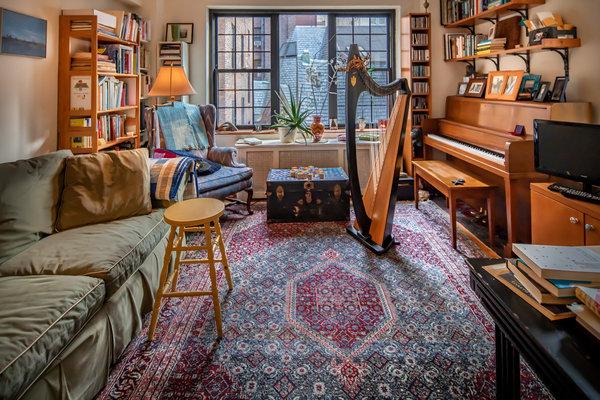Eager to try New York on for size, Mary Norris spent the summer after her junior year at Rutgers in a sublet on Ninth Street between Avenues B and C.
“This was way back in the early 70s, and it was really rugged over there,” recalled Ms. Norris, a former copy editor and proofreader at The New Yorker, and the author of the acclaimed 2016 memoir/language guide “Between You & Me: Confessions of a Comma Queen.” Her follow-up, “Greek to Me: Adventures of the Comma Queen,” was just published.
But life in the East Village was apparently too much of an adventure for the future punctuation royal.
“It was a little test I gave myself, and I failed it,” said Ms. Norris, 67, whose new book is an alpha-to-omega account of her passion for words and for the place that produced such glories as epics by Homer, ouzo and Kalamata olives (though not necessarily in that order).
Ms. Norris, a Cleveland native, gave New York another go with far happier results several years later, after graduate school. Over the next 20 years she lived in a series of rentals all over the city — the Upper West Side, the financial district, Astoria — before buying a one-bedroom co-op near Gramercy Park in 1997 and freeing herself from the caprices of landlords.
“However enlightened landlords are, it seems that eventually something goes wrong,” she said. “They’ll get mad if you have a cat or something, and I was tired of having to please them.”

Once the piano from her childhood home turned up, followed by the harp she bought from her sister, there wasn’t room for much else.CreditTony Cenicola/The New York Times
With the goal of pleasing herself, she looked for a neighborhood she had never lived in before (check); proximity to a green market (the Union Square market is less than half a mile away); an older building (hers was built in the 1920s); and outdoor space (well, you can’t have everything).
“When my real estate broker saw this place, she said I should come look at it,” said Ms. Norris, who had already rejected some 40 other possibilities. “And you know how it is: You have an address, and you’re walking down the street and you’re wondering, ‘Is it going to be this building? Is it going to be that one?’”
She added: “The entrance to this building is very understated; you can easily pass it. I walked in here, and I saw the light.” In every possible sense.
The sun appears between the surrounding buildings and pours in for a few hours every afternoon. The view from the casement windows, of a neighboring church, is similarly uplifting. “Not that I’m religious,” Ms. Norris said. “But what it means is that nothing will block the view.”
Mary Norris, 67
Occupation: Writer
Let there be light: “The apartment was very sparsely furnished when I came to look at it. The woman who was living here had a little round desk with a chair positioned so that it faced away from the window. I would never turn my back on my windows, whatever feng shui might say.”
After closing on the apartment, Ms. Norris found herself in a fix familiar to many New Yorkers: With the outlay for the down payment and the mortgage, furniture was a luxury she couldn’t quite afford. Then again, once the piano from her childhood home turned up, followed by the harp Ms. Norris bought from her sister, there wasn’t room for much else.
Her mother sprang for the sofa bed. The wing chair by the window and the upholstered desk chair came from a local thrift store. And the drop-leaf dining table came in from the cold: Ms. Norris found it near a curb on the Upper West Side.
“I sanded it and did a polyurethane job on it,” she said. “That was hard work, which explains why I haven’t done a lot of that sort of work.” She also sponge-painted the bathroom in colors meant to evoke the Mediterranean.
But really, why even mention the sofa or the slightly raddled wing chair or the loving-hands-at-home sanded dining table. It’s books, to paraphrase the novelist Anthony Powell, that furnish this apartment.
Irish literature, American literature, English literature, books about Freud, books about Greece and books on language, including Webster’s second edition unabridged dictionary — to name a few subject areas — fill narrow bookcases and wide bookcases, tall bookcases and squat bookcases. They cover the top of the piano and the custom-made shelves that were inspired by the shelves Ms. Norris saw in Rembrandt’s studio and Sir John Soane’s Museum. They fill the bookcases in the hall, with the overflow stacked on top. They sit in stacks on the floor, until the cleaning lady takes it upon herself to shelve them. Somewhere, anywhere.
“The books are in their own order,” Ms. Norris said. “They’re not alphabetized. They’re kind of in order of how much I love them.
“Things are piled everywhere,” she continued, not so much apologetically as merely stating a fact. “I would be happy if it weren’t so cluttered, but books are books. They are the main thing.”
The main thing, perhaps, but not the only thing. Ms. Norris is a keen believer in talismanic objects: the paperweight she found under the Williamsburg Bridge, a pine cone that survived a fire on the island of Thassos in northern Greece, the small figure of a goddess from Corfu and a small wooden block bearing her initials that she found on the street.
The apartment clearly has its own talismanic power. Here is where she produced her first book. Here is where she produced her second book.
“I have taken residencies to go and write,” she said. “But I get there and I think, ‘What am I doing here? I could be at home.’”
For weekly email updates on residential real estate news, sign up here. Follow us on Twitter: @nytrealestate.







